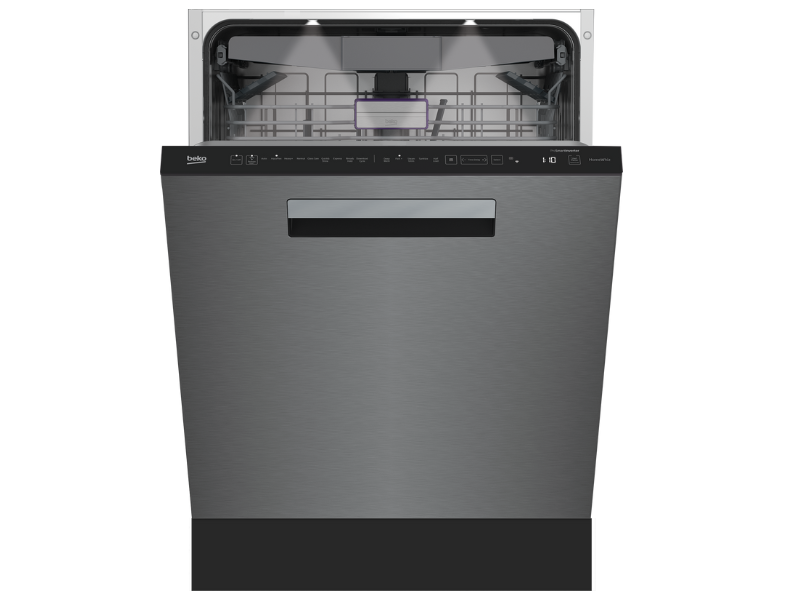Need more support?
Find FAQ's, video guides, articles and more.
Everything you need to know about
I need help with

Rinse aid and dishwasher salt are agents which ensure you get the best washing and drying performance from your dishwasher. Dishwasher salt is sold in granular form and helps your dishwasher’s internal softener unit reduce the hardness of the tap water.
Follow the instructions in your user manual to measure your tap water’s hardness level. If you’re having trouble finding your manual, download it here using your product’s model number.
If your water supply is soft (<5dH), don’t use salt as it may scratch or corrode glassware. If the water supply is harder, use of dishwasher salt is recommended.
When the salt light on your dishwasher comes on, it’s time to refill. The salt container is located on the inside of your appliance, below and to the left of the bottom dish rack. To access it, pull the bottom rack out and remove the protective cap of the salt container. Pour in the salt until it reaches the top of the container, then close the cap.
Dishwasher salt containers contain water, and this water may overflow when you fill the container with salt. Salt may also spill inside the appliance while refilling the salt container. Salt inside the dishwasher tub may scratch glassware. To minimize salt spills, use the funnel provided with your Beko dishwasher when pouring salt into the container, and be sure to wipe away any overflowing water or salt granules. Close the container lid tightly after refilling it. Run a prewash program or the shortest program to wash away any salt that may have been spilled inside the appliance. Salt granules under the lid will dissolve during prewash and may cause the lid to loosen. Check the lid at the end of the program and close it firmly.
Rinse aid and dishwasher salt are agents which ensure you get the best washing and drying performance from your dishwasher. Rinse aid disperses water from the surface of your dishes during the final rinse and helps with the drying process. It prevents water droplets from drying on your dishes and leaving water marks.
When the rinse aid light on your dishwasher comes on, it’s time to refill. The rinse aid container is located on the inside of your dishwasher’s door, next to the detergent container. Open the cover of the container, pour in the rinse aid until the containter is full and close the cover.
If you want your dishwasher to finish its cycle at a later time, you can delay the start or set an end time to the selected program on your dishwasher (depending on the model of your appliance). This is especially useful if the cost of electricity or water is lower at specific times of the day.
To set a delayed program, load your dishwasher and select the program along with any additional functions. Press the Time Delay function button to set when you want your appliance to start. Close the door of your appliance. Once the time delay has ended, the selected program will start automatically. While the Time Delay function is active, you cannot make changes to the washing program, additional functions or the delay period.
To cancel the Time Delay function, open your dishwasher’s door and hold the Program Selection/Program Cancel buttons simultaneously for three seconds. Then close the door of your appliance and wait for the draining process to finish.
For more information, head over to our guide on Beko dishwasher programs and features.
Be sure to use detergents that are specifically for dishwashers. There are three types of dishwasher detergents:
- Granular or powder detergents
- Tablets or gel packs
- Liquid or gel detergents
Don’t use dish washing liquid, hand soap, bleach, vinegar or any other chemicals under any circumstances as these products reduce your dishwasher’s performance, cause metal pieces to rust, and may even shorten the lifespan of your appliance.
Check the manufacturer’s instructions before putting an item in the dishwasher. Unfortunately, not all items have this information on their labels.
As a rule, avoid putting utensils that have stick-on parts, hand-painted dishes or porcelain items with gold or silver details in the dishwasher. Also, aluminum or aluminum-coated pots and pans can cause corrosion in your glassware.
Here is a list of common kitchenware that you should avoid washing in the dishwasher:
- Cast iron
- Crystal
- Hand-blown and hand-painted glass
- Wooden utensils
- Non-stick pans
- Copper pans
- Soft plastic
- Aluminum utensils
- Disposable aluminum
- Gold-plated dishes
- Insulated mugs
- Anything with adhesives
- China (hand-painted or antique)
- Hand-painted ceramics/stoneware
- Enamel
- Pewter
Every Beko dishwasher has a unique serial number. It’s located on the right-hand side of your appliance's door frame.

We're here for you!
Whether you need product advice, went to purchase accessories or simply want to give feedback - we're here for you.
(888) 352-2356 Monday through Friday 8 a.m. - 5:30 p.m. CSTNeed more support?
Find FAQ's, video guides, articles and more.